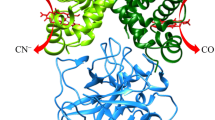Abstract
Dog hemoglobin has four sulphydryl groups per (tetramer) molecule located at the G18(111)a and F9(93)β positions. The two sulphydryls at the G18(111)a positions are unreactive toward nonmercurial sulphydryl reagents, but those at the F9(93)β positions are reactive toward these reagents. We have studied the kinetics of the reaction of dog hemoglobin with 5,5′-dithiobis (2-nitrobenzoic acid) as a function ofpH. At allpH values studied, the reaction is kinetically monophasic. Quantitative analysis of thepH dependence of the apparent second-order rate constant shows that two ionizable groups are linked to the reaction of the sulphydryl group. TheirpKa values are 5.57 and 9.0. These values are assigned to HisHC3(146)β and to the CysF9(93)β sulphydryl. We find that dog carbonmonoxyhemoglobin is significantly—almost an order of magnitude—less reactive than the aquomet, azidomet, and oxy derivatives. This result may be due to a greater tendency (at acidpH) for the salt bridge between HisHC3(146)β and AspFG1(94)β to form in the carbonmonoxy than in the other derivatives. Formation of this salt bridge is known to hinder access to the CysF9(93)β sulphydryl [Perutz, M. F. (1970),Nature228, 734–739].
Similar content being viewed by others
References
Antonini, E., and Brunori, M. (1969).J. Biol. Chem. 244, 3909–3912.
Beetlestone, J. G., Adeosun, O. S., Goddard, J. E., Kushimo, J. B., Ogunlesi, M. M., Ogunmola, G. B., Okonjo, K. O., and Seamonds, B. (1976). J. Chem. Soc. (Dalton trans.), Supplementary publication no. 21710, pp. 1251–1278.
Boyer, P. D. (1954).J. Amer. Chem. Soc. 76, 4331–4337.
Busch, M. R., Mace, J. E., Ho, N. T., and Ho, C. (1991).Biochemistry 30, 1865–1877.
Fersht, A. R. (1985).Enzyme Structure and Mechanism (2nd ed.), W. H. Freeman, New York.
Gibson, Q. H. (1973).J. Biol. Chem. 248, 1281–1284.
Guidotti, G. (1965).J. Biol. Chem. 240, 3924–3927.
Hallaway, B. E., Hedlund, B. E., and Benson, E. S. (1980).Arch. Biochem. Biophys. 203, 332–342.
Hensley, P., Edelstein, S. J., Wharton, D. C., and Gibson, Q. H. (1975).J. Biol. Chem. 250, 952–960.
Kwiatkowsky, L. D., and Noble, R. W. (1982).J. Biol. Chem. 257, 8891–8895.
Ohe, M., and Kajita, A. (1980).Biochemistry 19, 4443–4450.
Okonjo, K. (1980).J. Biol. Chem. 255, 3274–3277.
Okonjo, K. O., Taiwo, A., Balogun, M., and Ekisola, O. B. (1979).Biochim. Biophys. Acta 576, 30–38.
Okonjo, K. O., Vega-Catalan, F. J., and Ubochi, C. I. (1989).J. Mol. Biol. 208, 347–354.
Olson, S. T. (1976).J. Biol. Chem. 251, 1281–1286.
Palau, J., and Daban, J. R. (1978).Arch. Biochem. Biophys. 191, 82–89.
Perutz, M. F. (1970).Nature 228, 734–739.
Perutz, M. F., Fersht, A. R., Simon, S. R., and Roberts, G. C. K. (1974).Biochemistry 13, 2174–2186.
Perutz, M. F., Kilmartin, J. V., Nishikura, K., Fogg, J. H., Butler, P. J. G., and Rollema, S. H. (1980).J. Mol. Biol. 138, 649–670.
Robyt, J. F., Ackerman, R. J., and Chittenden, C. G. (1971).Arch. Biochem. Biophys. 147, 262–269.
Shaanan, B. (1983).J. Mol. Biol. 171, 31–59.
Taylor, J. F., Antonini, E., Brunori, M., and Wyman, J. (1966).J. Biol. Chem. 241, 241–248.
Vega-Catalan, F. J. (1987).Comput. Chem. 11, 185–194.
Vega-Catalan, F. J., Odeyemi, O. J., and Okonjo, K. O. (1986).J. Biol. Chem. 261, 10,576–10,581.
Author information
Authors and Affiliations
Rights and permissions
About this article
Cite this article
Okonjo, K.O., Adejoro, I.A. Hemoglobins with multiple reactive sulphydryl groups: The reaction of dog hemoglobin with 5,5′-dithiobis (2-nitrobenzoate). J Protein Chem 12, 33–37 (1993). https://doi.org/10.1007/BF01024911
Received:
Published:
Issue Date:
DOI: https://doi.org/10.1007/BF01024911




